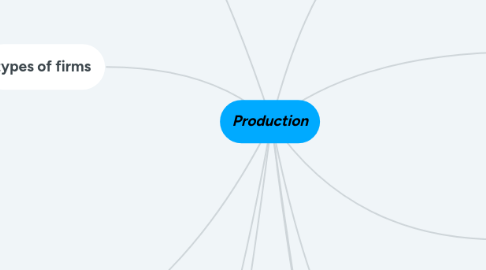
1. Types of integration
1.1. Horizontal integration
1.1.1. e.g. merger or takeover
1.2. Vertical Integration
1.2.1. Forward Vertical Integration
1.2.1.1. e.g. towards retail
1.2.2. Backward Vertical Ingration
1.2.2.1. e.g. towards raw material supply
1.3. Lateral integration. conglomerate merger
1.3.1. different industry
2. productivity
2.1. the amount of output(good and services) that can be produced from a given amount of input
2.2. Increasing productivity:
2.2.1. Specialization of production
2.2.2. Division of labour
2.2.2.1. advantages
2.2.2.1.1. more goods and services can be produced
2.2.2.1.2. full use is made of employee's abilities
2.2.2.1.3. time is saved
2.2.2.1.4. it allows the use of machinery
2.2.2.2. disadvantages
2.2.2.2.1. work may become boring
2.2.2.2.2. workers may feel alienated
2.2.2.2.3. products become too standardlized
2.2.3. Replacing old technologies with new technologies
2.2.4. Training workers
2.2.5. Reward increased productivity with performance-related pay
2.2.6. Encourage employees to buy shares
2.2.7. Increase job satisfaction
2.2.8. Lean manufacturing
2.3. How to calculate labour productivity
2.3.1. Average product of labour = total output per period / no. of employees
2.3.2. Average revenue product of labour = total revenue per period / no. of employees
3. types of firms
3.1. sole trader
3.2. partnerships
3.3. limited company
3.3.1. private limited company
3.3.2. public limited company
4. factors of production
4.1. capital
4.1.1. this include the tools or machinery needed in the production
4.2. Entrepreneurship
4.2.1. the person who combine the other resources to form a product of service tp earn profit
4.3. land
4.3.1. this includes all all natural resources or raw materials needed in the production. for example:oil, natural gas, wood
4.4. labour
4.4.1. the effort that people contribute to production of goods and services
4.5. Combining factors of production
4.5.1. Labour intensive
4.5.2. Capital intensive
4.5.3. Factor Substitution depends on
4.5.3.1. Consumer demand
4.5.3.2. Market prices of capital & labour
4.5.3.3. Productivity of capital & labour
4.5.4. Difference between factors
4.5.4.1. Capital: automated mass production
4.5.4.2. Labour: personalised work
5. how firms grow in size
5.1. internal growth
5.1.1. expanding scale of production
5.2. External growth
5.2.1. merger
5.2.1.1. one or two more firms agree to join together
5.2.2. takeover/acquisition
5.2.2.1. having enough share in the ownership and take overall control
6. how to measure size of firm
6.1. number of employees
6.2. organization
6.3. capital employed
6.4. market share
7. Industries
7.1. Primary
7.2. Secondary
7.3. Tertiary
8. Profit and cost
8.1. Profit
8.1.1. Total revenue-total cost
8.1.2. To maximize:
8.1.2.1. Boost demand
8.1.2.1.1. Advertising
8.1.2.1.2. Pricing strategies
8.1.2.2. Minimize cost
8.1.2.2.1. identify & measure costs of all factors of production
8.2. Cost
8.2.1. Variable cost
8.2.1.1. E.g. electricity, cost of product
8.2.2. Fixed cost
8.2.2.1. e.g. mortgage payments, rent, cleaning cost
9. economies of scale
9.1. average or unit cost can be reduced as a firm grows in scale because it gives the management or owners a chance to recognize the way the firm is running is financed. Such decisions are taken within the firm so the advantages or economies they bring are known as internal economies of scale.
10. market structure
10.1. perfect competition
10.1.1. large number of different firms competing to supply an identical product and an equally large number of consumers wanting to buy it.
10.2. imperfect competition / monopolistic competition
10.2.1. one or more competing firms have a degree of control over price setting and can influence demand. #not identical goods
10.3. monopoly
10.3.1. a firm is the only supplier of a good or service wanted by consumers

